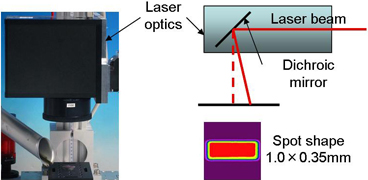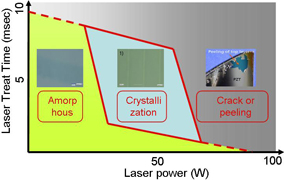- Home
- News Release
- News archives (2013)
- Ricoh Succeeds in Crystallization of PZT Film Using Laser Annealing Technology
News Release
Ricoh Succeeds in Crystallization of PZT Film Using Laser Annealing Technology
TOKYO, May 21, 2013 — Ricoh Company, Ltd. (President and CEO: Zenji Miura), has succeeded in crystallizing PZT (lead zirconate titanate)(*1), produced in inky form by CSD method (*2), using unique technology. The technology applies a semiconductor laser and has proved that the film obtained exhibits the displacement characteristics proper to PZT. Ricoh is the first in the world (as of May, 2013) to obtain the PZT film, which has displacement characteristics, with its original irradiation technology using a semiconductor laser among laser annealing technologies (*3).
This technology, when combined with the piezo element (*4) formation technology by IJP method (an ink-jet printing technique) that Ricoh announced in May, 2012, makes it possible to plot an actuator (*5) of a minute size (several to several hundred microns) as a 3D modeling pattern on a silicon substrate. It uses piezo material crystallized with laser annealing technology for molding. In addition to the field of MEMS that includes imaging equipment, hard disk drives, and displays requiring a displacement function in minute area, these technologies can evolve for use in the field of sensors, capable of measuring minute pressure and acceleration.
Although PZT material is used for many piezo elements, such as sensors and actuators, what Ricoh developed this time applies laser annealing technology to produce PZT film using the CSD method in the crystallization process. Until now, this crystallization process was made by heating to about 750 ℃ in an electric furnace, where almost all heat capacity was used to raise and lower the temperature of the substrate and furnace itself, resulting in significant waste of heat capacity and run time. With the laser annealing technology, because only the section irradiated by the laser beam is heated locally, there is no wasted energy, as only the PZT film on the substrate is heated.
The problem with crystallization annealed by laser lay in how to uniformly improve crystallinity without causing cracking and peeling. To solve this problem, there was a need to make the temperature at the time of irradiation uniform, even with the laser beam. Ricoh achieved the solution by developing a unique optical system capable of (1) making the geometry of the laser beam spot rectangular (circular in usual) to conform with the device form, and (2) making the intensity distribution of laser beam (beam profile) oblong (Gaussian distribution in usual). Beyond that, the cracking and peeling problem was solved by rationalizing laser power and irradiation time.
| Laser unit and spot form | Laser irradiation condition and PZT film surface condition |
|
 |
 |
Globally, there are only a few cases where PZT film has been obtained with a displacement characteristic using laser annealing technology. The other cases use excimer laser irradiation, making the systems large and expensive; they also require long processing time because of pulsed laser radiation. Ricoh's process, on the other hand, uses a semiconductor laser, keeping the system small and inexpensive and yielding the further advantage that it can be processed in a short time because of continuous light.
To produce a PZT film by the CSD method, heat for drying and pyrolyzing, other than for crystallization, is also required. Although laser annealing was applied to the most important crystallization process to determine the film properties here, it is also applicable to the drying and pyrolyzing processes. With the laser annealing technology adopted for all heating processes, our tentative estimation shows that the CO2 exhaust can be reduced to about one-tenth, and the processing time can be halved that of the process using an electric furnace.
This technology was developed through joint research with the Fraunhofer Institute for Laser Technology of Germany, (also known as: ILT) with RWTH Aachen University (Rheinisch-Westfaelische Technische Hochschule Aachen).
Ricoh will announce this technology at "The 30th Meeting on Ferroelectric Materials and Their Applications (FMA30)" to be held in Kyoto from May 22 to 25, 2013.
- *1PZT (lead zirconate titanate): A solid solution ceramic of lead zirconate and lead titanate; it is used for the piezoelectric ignition element in household gas appliances, ultrasonic transducers, piezoelectric buzzers, etc. This piezoelectric material presently is the most versatile.
- *2CSD method: The abbreviation of Chemical Solution Deposition method, also called the sol-gel method, is to synthesize a material by starting with gelification of the sol solution. It is a low-temperature synthesis method and can be applied to synthesize materials of various microstructures, topologies and functions.
- *3Laser annealing technology: A technology to cause transformation in metal or semiconductor’s crystal lattice by thermal action of laser irradiation. This technology has the features that local annealing treatment (heat treatment to obviate internal distortion by heat) of the required section only is possible and that it can be processed in a short time.
- *4Piezoelectric element: An element expanded and contracted by applying a voltage. Further, the phenomena of deformation when a voltage is applied or of being charged when external force is applied are also called the piezoelectric effect.
- *5Actuator: A mechanism to convert input energy into physical movement. An actuator, generally called, is a device to convert electrical energy into movement and is widely used for household appliances, in the aeronautics industry and in the research of artificial muscles.
Relevant Technical Information
For full version in PDF format